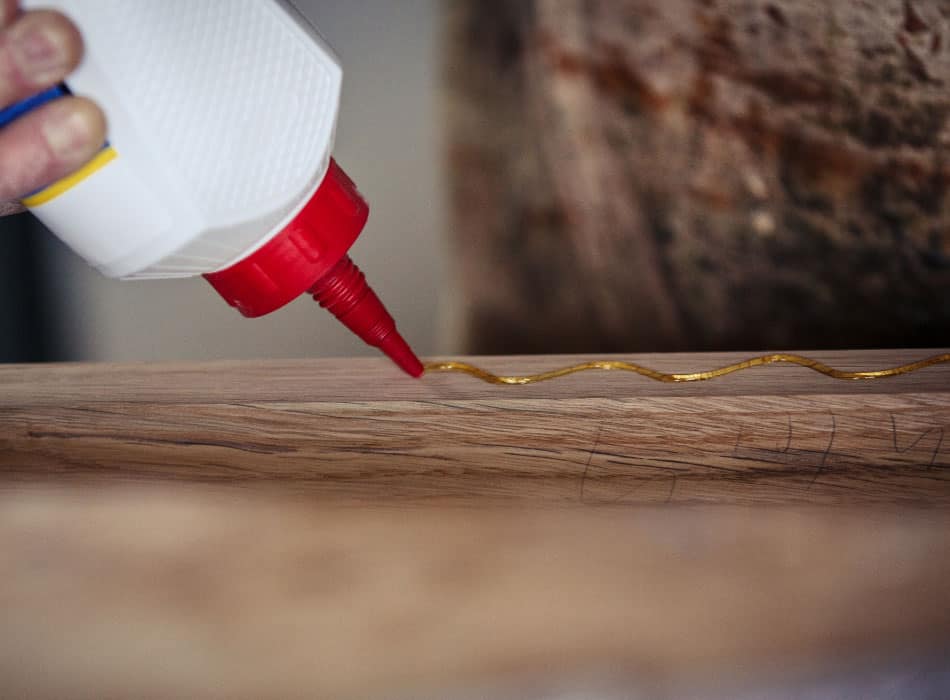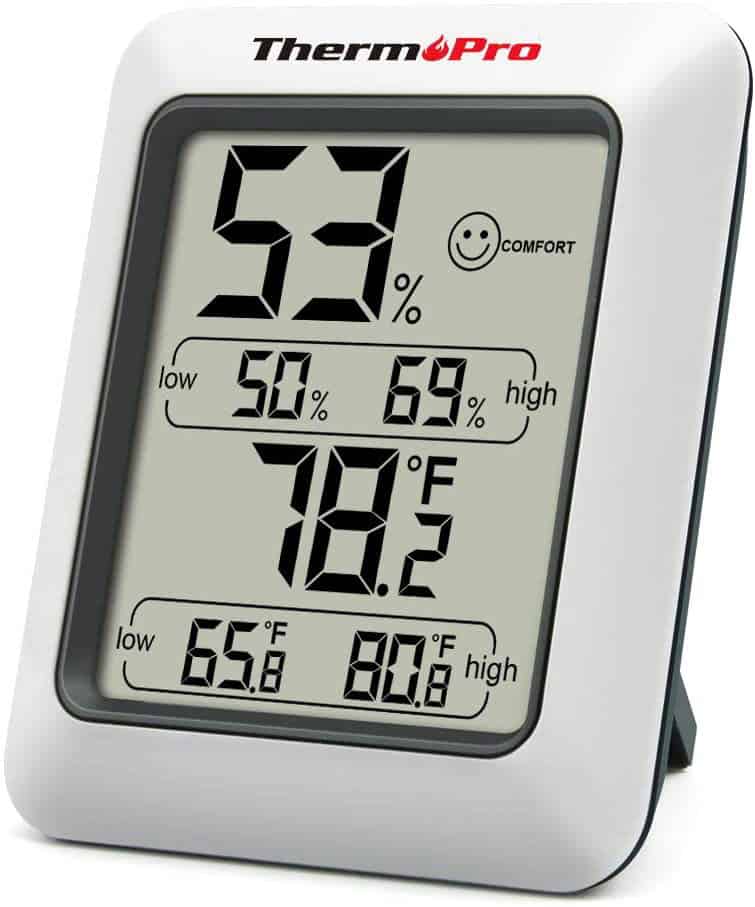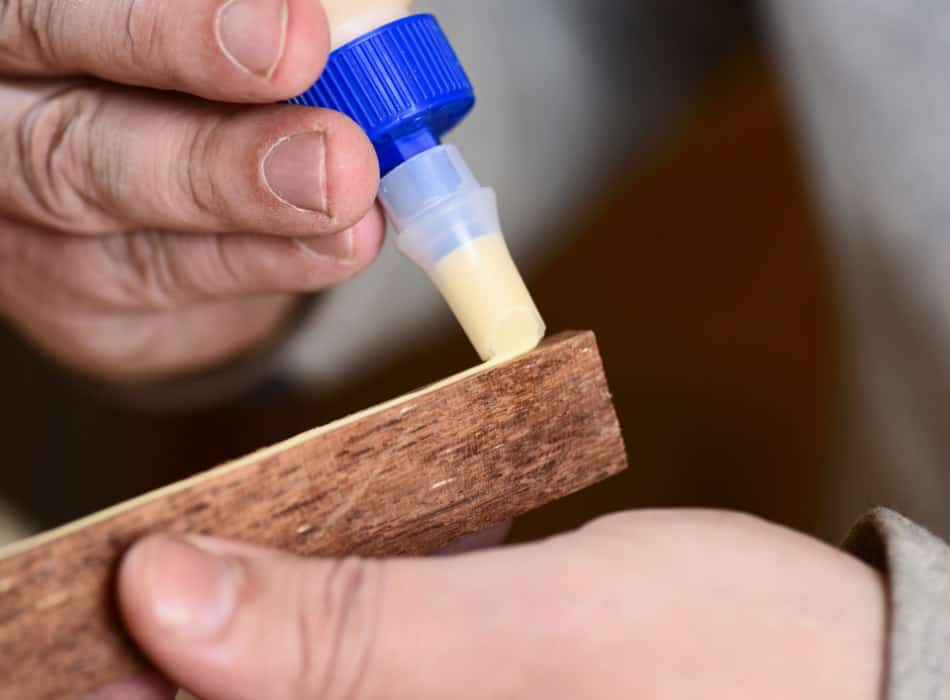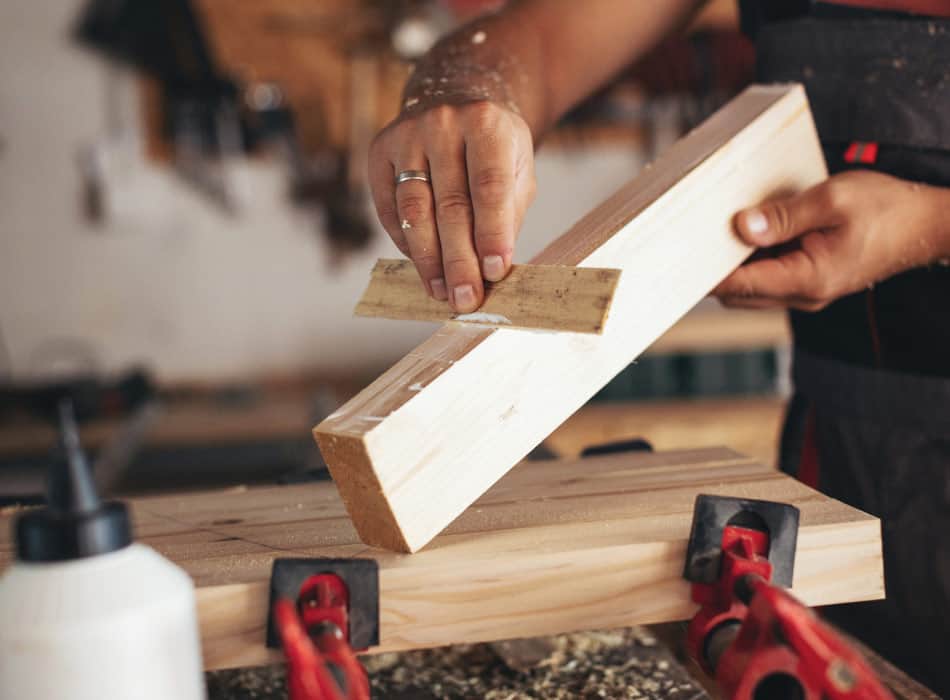I know that feeling of frustration when you spend an hour getting all the parts lined up and carefully applying the clamps, only to come back later and find out the wood glue won’t dry! Why?
Most Wood Glues will dry within a few hours given the right conditions, however, some may not dry due to one of the following 8 reasons:
- The temperature is too cold
- Poor Air Circulation around glue joint
- High humidity in the air
- The material being bonded is not porous
- The wood has a high moisture content
- The wood is very oily
- The wood glue is beyond its use-by date
- Using the wrong type of wood glue
Let me explain each one of these items a little more so we can hopefully figure out why your wood glue is not drying.

1. What Is The Temperature Of Your Workshop?
Most wood glues operate well within a certain temperature range. It is possible that your workshop or the timber you are gluing is too cold.
PVA for example is best applied at room temperature between 50-77°F (10-25°C). Any colder than that, the glue films will not form properly and the glue will not dry.
Be sure to click here to see what happens when wood glue is frozen!
I have put together this handy table to show what the ideal operating temperatures are for 5 of the most common wood glues.
| Type Of Wood Glue | Ideal Operating Temperature |
| Polyvinyl Acetate (PVA) | 50-77°F (10-25°C) |
| Polyurethane | 50-95°F (10-35°C) |
| Cyanoacrylate (CA) | 41-200°F (5-93°C) |
| Animal Or Hide | 120-150°F (48-65°C) |
| Epoxy | 41-95°F (5-35°C) |
Temperatures will vary slightly between each glue type but this gives you a good indication of what each type of glue can do.
If you are trying to use wood glue outside of these temperatures, there is a good chance that your glue will not dry.
To combat this, I suggest using a heater to heat the room up or even heat the timber up you are trying to glue. Be careful with heat though as too much can soften some glues and make them weak.
PVA wood glue is suspended in water. It drys by the water-absorbing into the timber or by evaporation. A gentle amount of heat can help disperse this water and speed up the drying time.
2. Do You Have Enough Air Circulation Around Your Glue Joint?
No matter which would glue you are going to use, you always need to ensure you have good air circulation around your joints.
Almost all wood glues require airflow to help make them dry. Insufficient airflow can delay the glue drying process and sometimes cause them to not dry at all.
PVA wood glue is suspended in water particles and requires some air to help evaporate this water to make it dry.
Here is what you should when applying glue to your next project:
- Ensure you are working in an open area
- Open the doors to your workshop to promote circulation
- Use a fan if in doubt
Most workshops or garages all have plenty of airflow even when the doors are closed. Air can get in around doors and windows so you should be fine.
3. Does Humidity Affect Wood Glue Drying?
Humidity refers to the amount of water vapor that is held in the air. If you live in an area that usually has high humidity, then you will find that things take longer to dry.
Humidity has a major impact on how long it will take wood glue to dry. In 40-60% humidity and a temperature of around 50-70°F (10-22°C), wood glue will need to stay clamped for 1 hour.
Wood glue dries by the water in the glue evaporating into the air or by being sucked into the wood. High humidity of over 70% usually doubles the amount of time it will take for wood glue to dry.
The opposite will apply to areas that usually have low humidity whereas they will find wood glue will dry a lot faster and in some cases, it will dry in 30 minutes or quicker!
How Do I Check The Humidity?

It is a good idea to have a look at your local weather forecast or you can buy a hygrometer that will measure the humidity in the air. This is the one I use that also has a thermometer.
This might seem like a hassle but if you plan on doing a few glue-ups, then making sure you do it at the best time will save you time later on.
An example of high humidity would be when you get a thunderstorm and rain event. Humidity will reach 100% saturation which will be a bad time to start using wood glue.
4. Is The Material You Wish To Bond Porous?
This really only applies when using PVA Wood glue. PVA requires the material it is bonding to be somewhat porous as this allows the glue’s molecules to bond with the cells of the wood.
PVA wood glue does not stick well to smooth surfaces and more often than not, the glue will not dry. I have included this topic as I know most people in woodworking will be using PVA.
5. Check The Moisture Content Of Your Wood

All wood contains some level of moisture. Most woods for woodworking and furniture making will sit around 6-10% moisture content. Most wood glues are best suited for dry woods of around 8% moisture content with the exception of Polyurethane and Epoxy glues.
Some PVA wood glues can be used at higher levels of 10-15% moisture content.
If you using wood with high levels of moisture, the wood glue will be very slow at drying as the moisture cannot disperse from the glue. Excess moisture can also weaken the glue.
You will find that your woodworking project will last much longer if the moisture content in the wood is very similar to the environment in which it will be kept.
If you plan on making a table from really dry wood and then keep the table in a place of high humidity, the wood in the table will absorb moisture over time. If levels are too high the wood will expand and cause excess pressure on your glue joints.
It is very important before starting any woodwork project that you check the moisture level in your wood using this moisture meter.
6. Is The Wood Oily?
I know you have not coated your wood in oil, but it important to realize some tropical woods contain natural oils and resins which can affect glue drying times.
Oily woods will prevent water-based glues from penetrating and wetting the surface of the wood resulting in the adhesive staying wet and not drying.
How to Glue Oily Woods?

Fortunatley there are ways to glue together oily woods. For these, I suggest not trying regular PVA.
The following procedures are what I use if I’m going to be working with oily wood:
- Use a solvent on the surfaces of the wood that are to be glued – A solvent such as mineral spirits and the best way to get rid of the excess oil on the surface of the wood. Check your cloth as soon as you wipe it and you will notice an oily residue on the cloth. Your wooden parts should then be glued up straight away before the oil comes back to that area.
- Try sanding the grain – Sanding can help remove that polished surface your wood may have and can also get rid of excess surface oils. Use medium-grit sandpaper and this may help provide a bond for your glue.
- Use Nonwater-based glues – Oily types of woods are best glued using Polyurethane or Epoxy type glues. Cyanoacrylate (CA) glue will also work for small areas.
Check out this list of Oily woods.
7. Your Wood Glue Could Be Out Of Date
If you are only doing a little bit of woodwork now and then, you will find that your bottle of glue will last a long time. Great news on the hip pocket but no so good news on your woodworking joints.
The shelf life of most PVA wood glues is 1-2 years if stored in a cool dry area. In most cases, wood glue can last much longer typically up to 5-6 years. To gain extra shelf life from your wood glue, you can keep it in your refrigerator.
Having said that, it should only be very cool for optimal storage conditions and should never allow your wood glue to freeze. See what happens here when your wood glue freezes.
You will know your wood glue is beyond its best when the consistency is off and the color may seem unusual. If in doubt, always throw it away and grab a new one.
Wood glue that is out of date is not recommended as this may well be one possible cause of why your glue does not dry. This may also lead to poor joint strength due to the glue being aged.
Wood glue should pour very easily and should have any lumps in it. You can however add a small amount of water and give it a good shake to help bring it back to liquid form.
8. Are You Using The Wrong Type Of Wood Glue?
Wood glue comes in many varieties and it is important you choose the right wood glue for your project. I have listed below the different types of wood glue available to see if you are choosing the right one.
| Type of glue | Common Names | Commonly Used For |
| Polyvinyl Acetate (PVA) | Titebond, Elmers glue | Paper, Craft, Wooden products |
| Polyurethane | Gorilla Glue | Porous woods, end grain gluing, stone, metal, glass |
| Cyanoacrylate (CA) | Super Glue | Instant bonds to most materials |
| Animal Or Hide | Hide Glue | Instruments and Bow making |
| Epoxy | Epoxy Glue | Wood, Metal, plastics, ceramics, concrete |
Polyvinyl Acetate (PVA)
This is the most popular and common wood glue and one that you would be most likely using. PVA is generally not water-resistant although there are a few types that are. Titebond is an excellent wood glue that I use every day and its Type III is fully waterproof.
PVA is easy to get and comes in many forms and is most suitable for any wood-based products and is great for woodworking in general.
Pros
- Easy to access
- Relatively cheap
- Easy to use
- Long working time
- Strong bond on most woods
- Great for craft
- Won’t turn yellow
- Non-toxic
- Cleans up in water
Cons
- Weak on end grain connections
- Most are not suitable outdoors
- Only best for wood-based products
- Needs to be cleaned up straight away to avoid marking the wood
Drying Time
PVA wood glues usually dry in around 30 minutes but they need to be left for 18-24 hours to fully cure. It is best to leave your workpiece in the clamps for the full 24 hours to ensure you get the best bond.
Reasons For Not Drying
- Are you using it on a non-wood product? – PVA really only works well on wood products. If you used on any other materials it may not dry.
- Have you applied too much? – Excessive amounts of PVA may take quite a lot longer to dry.
Polyurethane
Polyurethane is becoming used in woodworking more and more due to the extra strength it has. This type of glue is mostly known as Gorilla glue simply because they were the first company to make it widely accessible.
Polyurethane is great due to its ability to bond many other surfaces such as glass, rubber, concrete & ceramics.
It does not get drawn into wood fibers as much because it is not water-based meaning you are less likely to get wood staining and can accept a better clear finish.
Pros
- Easy to access
- Inexpensive
- Works on many materials
- Perfect for woods with high moisture content
- Perfect for oily woods
- Sticks to stains and varnishes
- Great for gluing end grain
- Fills joints as it dries as it expands
Cons
- Needs some form of moisture to cure
- Can be messy if you use too much
- Needs a solvent to clean up
- Less working time
- It expands when it cures which can move parts
- Only has a short shelf life of 1 year
Drying Time
Polyurethane wood glue will be dry in 1-2 hours so it is important to leave wood clamped for that time. It fully cures in 24 hours. Polyurethane wood glue dries by a chemical reaction that is triggered by moisture either in the air or in the wood.
This makes it the perfect glue for oily woods or wood with high moisture content.
Reasons For Not Drying
- There may be not enough moisture available – Polyurethane requires some moisture either from the wood or the air to dry. If you are using a very dry wood or live in a place with very low humidity, your glue may not dry properly or it will take a long time.
For very dry woods, considering spraying the wood with a light mist of water first for best results.
Cyanoacrylate (CA Glue)
CA glue is somewhat like a super glue where it bonds almost instantly. It does come in a couple of different forms. Some are available as a single one part while others have an activator.
CA glue will bond most surfaces and is an ideal glue for small parts and surfaces only.
Pros
- Glues instantly
- Easy to use
- Ideal for small parts
Cons
- More expensive than PVA or Polyurethane
- Can be brittle when dry
- Can’t be used in large areas
Drying Time
CA Glue dries within 10 seconds for most types and will need a full 8 hours to fully cure.
Reasons For Not Drying
- Very cold temperatures – CA glue is will dry under most conditions but we have found that very cold days usually take a lot longer to dry.
Animal Or Hide Glue
These types of glues are sometimes even referred to as protein glues and are the oldest types known to mankind. Some say they date back to Egyptian times.
Animal or hide glue is basically made from any or all parts of an animal and comes in a granular form which should last a long time in a dry environment.
Pros
- Very strong wood glue
- Ideal for small joints in clock making or Instruments
Cons
- Very short working time around 1 minute
- Hard to use as it needs to be melted in warm water
- Poor gap filling properties
- Short shelf life
Drying Time
Animal or hide glue will fully set in 12-24 hours under normal conditions. It dries by moisture being pulled from it by the wood.
Reasons For Not Drying
It often does not dry properly because woodworking joints are not tight enough. This glue dries by moisture being pulled from it by the wood being glued. If your joints have any gaps in them, the glue just pools and the excess moisture cannot escape meaning it will stay gluggy and not set.
If you know that your joints are not 100% perfect, I definitely recommend not using this type of glue.
Epoxy
Epoxy glue is great for gluing up composite materials which require a great deal of strength and needs to dry quickly.
It is often used to glue up timber benchtops of joints in boats as it sets rock hard and provides a great waterproof joint. Most epoxy glues dry clear and some with a slight yellowish tint.
Pros
- High Strength
- Durable
- Perfect for composite materials
- Dry quickly
- Waterproof
- Great gap filling properties
Cons
- Some have to be mixed with hardener
- Messy
- Cures best in warm temperatures
- Emits a lot of fumes
Drying Time
Most epoxy glues dry within 20 minutes and should be left to sit for 24 hours before any stress is applied to the joint.
Reasons For Not Drying
Most epoxy glues require a Part A glue and Part B hardener which needs to be mixed together at the right ratio to dry. If you fail to mix these right, it will drastically affect drying time and in some cases, it may not even dry at all.
Some epoxy glues also require a high ambient temperature to cure properly which can be hard in some climates or is limited to the time of year to use.
Conclusion – Reasons Your Wood Glue Won’t Dry
We have discussed most of the common types of wood glues in this article and the reasons why they dry and why some don’t. Generally, if I have used the right wood glue in the right conditions, it will always dry.
Before you start gluing up your next project, I recommend you check you have all of these 8 items right to ensure your glue does dry.
Let’s face it, trying to pull joints apart and clean up glue that has not dried is a very messy and frustrating job. I hope this has helped you understand why your wood glue won’t dry!




